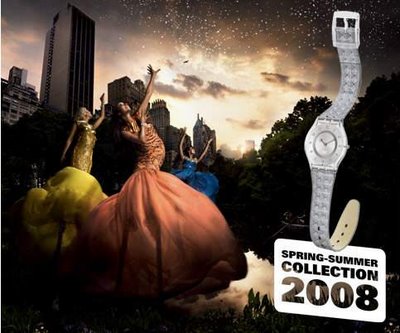It is often stated that the goal of an advertisement is to create a need out of an object that is otherwise may not be considered an essential element. In other words, advertisement is instrumental in developing and constructing a need for an object or product. This concept is thoroughly stated in the article by Kuntjara, “By substituting desirable images for concrete needs, modern advertising seeks to transform desire into necessity“. (Kuntjara, 2) To execute this essence of need or necessity, modern advertising relies on symbols, stories, and characters to sell products. It can well be stated that human behavior is altered by stimuli outside the mind but absorbed by that same mind. This absorption must be considered when understanding the human psyche. Advertisement tends to increase the need and create needs. However, the nature of need changes with time and taste and this is exactly what we see while viewing the two Swatch advertisements. The differences and the similarities between the two Swatch advertisements reflect changing cultural values.
The first, and the older, advertisement is from a time that is beyond the known world of the public internet, information technology, and globalization. The world of that era was much more confined within its culture than today. This advertisement has a thorough caption. It states, “Swatch watch: Spirited gathering takes time to probe meaning of equinox. Finding none, they party.” There is almost a narrative context to this advertisement. It tells a story. It refers to the younger generation and induces them to have fun and party. The basic audience of this advertisement is the younger generation. The characters are all clad in local dresses that are familiar to the day-to-day cultural life of the audience. The indication is sporty and very young. As per the narration, there is also a bedtime story to tell. However, this was the time before the popularity of Latino culture and the abstract world of Gabriel Garcia Marquez.

In recent years with the development of the concept of the global village, hybridization is fast becoming the order of the day. In this concept, it becomes necessary for an industry to meet the needs of both local and global markets all at the same time. Moreover, no industry is a better example of meeting this dual market at one given period than the advertisement industry to ascertain a formulation of this phenomenon of globalization and hybridization.
The new Swatch advertisement can be well emulated as a prime example of globalization and hybridization in a market where the maxim is to go beyond the parameters of the local market structure and capture the global audience. Thus, it could narrate the aspect of the basic issue globalization and hybridization is but a two-way approach and where the basic maxims of the capitalistic economy are taken into consideration at every step of formulating the strategies of marketing. The basic impetus of any business is to deal with the principals of profit and the methods of maximization of profit margin. Nevertheless, they remained focused mainly on the aspects of corporate issues and social context.
Globalization indeed means the broadening of global linkages, while also impacting upon the social and cultural dimensions of the global society, hence propagating one-world citizenship which has one economy, one culture, and one social order. Ecumenically globalization’s definition would be complete with the above classifications. But there are many inroads in the understanding of the term. This is the process with which the poor countries can think of modernization and global competition, enhanced living standards, and work opportunities; on the other hand, this very same process is the one which can destroy economies by the sudden influx of foreign capital, can destroy marginalized workers livelihood and destabilize national banks. Hence, globalization is like a coin – with two very separate sides. The new audience of Swatch has changed by the changing cultural norms and has taken a liking towards anything exotic- be it less known culture or philosophy. This way cultures change and it changes the population that once was native to it. The new generation of internet-savvy information-fed professionals is interested in the fundamental aspect of graphical representation with fewer words and more information.

The new Swatch hardly is interested in telling any narrative and there are no captions included too. It is all visualization essence of elation rather than fun and frolic as in the case of the older advertisement. This advertisement is more about impact rather than the message. The influence of Latino culture is vibrant all over the frame with colorful flamingo dancers and the mystic lights are the influence of the magic reality of Gabriel Garcia Marquez unlike the flat and normal lights and colors of the older version. In the background, there are high rises, a synonym of US urban life and there is only one use of letters. It conveys the arrival or launch of the Spring-Summer collection of 2008. The entire essence of this new advertisement is very rich, exotic. It is as if to indicate that the new version of the watches is for the neo-IT rich professionals who are young, upward mobile, classically tasteful but still represent the general population. This is the biggest difference between the two eras.
Still, there are some similarities between the two advertisements. Both the advertisements are targeting the youths as an audience. Both the advertisements are interested in the general population by influencing them with the vibe of the cultural essence. However, the fact remains that the common ground of marketing, culture, for both the advertisements has changed in the meantime.
However, this specific issue could have been dealt with a certain truth in a much better manner if the truth had been evaluated and taken into consideration that the matter of money is about not only accumulation of money but also accumulation of power. Thus it could be ascertained that society and everything related to the society is evolved and metamorphosed by the manipulation of economy and globalization and hybridization is a no different issue in this context. True it is to the context but seen from a sociological point of perception. If the writers had been approaching in a manner keeping in mind an economic background this sociological impact would have fallen in place quite easily.
In present-day society, the destruction of traditional cultures to initiate them into the global monoculture is more subtle than it was in the past. Most corporate and government leaders do not intend to destruct traditional cultures; for the most part, they are often unaware that they are doing so. This lack of realization seems to be nurtured by the cult of specialization, which is ever-present in western society. This allows the tendency to destroy the cultural diversity of the world to spread and expand the global economy.
Finally, it would not be irrelevant to conclude that with the advent of information technology and the internet it is almost impossible today to stay away from the concept of global monoculture. Be it Indonesia or western Africa, sooner or later every aspect of human life and thought process would be included within the threshold of the ‘brave new global village’ obviously nurtured and edited in accordance to the western tradition and taste. The computer and technology revolution of the past twenty years has given executives even more reason to disrupt and destroy cultural diversity, attempting to “do what is best for each society and the world,” without, in fact, considering how these revisions affect each society. Nevertheless, values well-fed and induced by the global market economy inject us the benefits of an open world where all existing geological maps must be included into one brand name of culture and as the advertisements generally suggest- this is the ‘in-thing today.
To sum it up it would be very relevant to state that in our all-utilitarian materialistic market economy driven needs of urban life the advertisements play a vital role. In this whole world of ‘earn to burn’ philosophy, it is all but evident that we should be living in a virtual make-believe world of utopia more like Aldous Huxley’s ‘Brave New World’. Down the ages of history, all the human clans ever came to existence created utopia in accordance to their own culture and taste and the global village and hybrid culture a single monoculture is developing. The new Swatch is an indication of this single global culture.
Works cited
Kuntjara, Esther H; Beauty and the Beast: Images of Women in Advertisements; Nirmana; Vol 3, 2, 2001; pp 97-106; Petra Christian University.